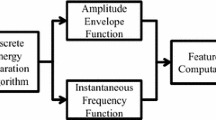Abstract
The aim of this work is to compare the performances of 5 classifiers (linear and quadratic classifiers, k nearest neighbors, Parzen kernels and neural network) to score a set of 8 biological features extracted from EEG and EMG, in six classes corresponding to different sleep stages as to automatically elaborate an hypnogram and help the physician diagnosticate sleep disorders. The data base is composed of 17265 epochs of 20 s recorded from 4 patients. Each epoch has been classified by an expert into one of the six sleep stages. In order to evaluate the classifiers, learning and testing sets of fixed size are randomly drawn and are used to train and test the classifiers. After several trials, an estimation of the misclassification percentage and its variability is obtained (optimistically and pessimistically). Data transformations toward normal distribution are explored as an approach to deal with extreme values. It is shown that these transformations improve significantly the results of the classifiers based on data proximity.
Preview
Unable to display preview. Download preview PDF.
Similar content being viewed by others
Author information
Authors and Affiliations
Editor information
Rights and permissions
About this chapter
Cite this chapter
Becq, G., Charbonnier, S., Chapotot, F., Buguet, A., Bourdon, L., Baconnier, P. Comparison Between Five Classifiers for Automatic Scoring of Human Sleep Recordings. In: K. Halgamuge, S., Wang, L. (eds) Classification and Clustering for Knowledge Discovery. Studies in Computational Intelligence, vol 4. Springer, Berlin, Heidelberg. https://doi.org/10.1007/11011620_8
Download citation
DOI: https://doi.org/10.1007/11011620_8
Published:
Publisher Name: Springer, Berlin, Heidelberg
Print ISBN: 978-3-540-26073-8
Online ISBN: 978-3-540-32404-1
eBook Packages: EngineeringEngineering (R0)




